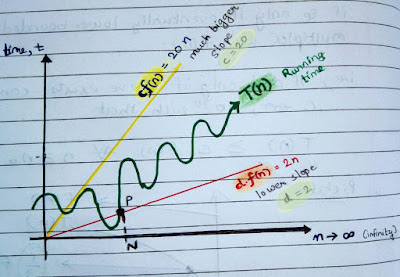Before reading this notes, I recommend you to read following articles:
- Big-Oh : In Layman's terms
- Big-Oh : Theory & Calculation
- Big-Omega : Theory & Calculation
You can have both lower bound and upper bound on a function.
If
If
It's read as
Big-Theta Notation ( )
)
Definition: - i.e.,
is the set of function
that are in both
and
for all
. Thus, we have an asymptotic tight bound on the running time. "Asymptotic" because it's paramount only for large values of n. "Tight bound" because the running time is nailed within a constant factor above (upper bound) and below (lower bound).
- It is used to compare 'run-time' or growth rate between two growth functions.
- Another method to determine the condition:
 |
| Fig. 1: Time-complexity : Graph to illustrate the concept of Big-Theta Notation |
Explanation:
- If we have any function which fits between lower linear line
and upper linear line
as
then, that function is in
.
- In Fig. 1, initially, the graph T(n) is not between the lower and upper bound. But, after a while its' always between the lower and upper bound. So, this function is said to be in
.
Note: If \in&space;\Theta&space;(g(n))&space;\Leftrightarrow&space;g(n)&space;\in&space;\Theta&space;(f(n))) .
.
Example:- &space;\Rightarrow&space;3n^{3}-n^{2}\in&space;\Theta&space;(n^{3}))
When we say that a particular running time is we mean to say that once T(n) gets large enough, the running time is at least
we mean to say that once T(n) gets large enough, the running time is at least  and at most
and at most  .
.
Imagine :- (Observe 'Fig. 1' while reading this): For some trivial values of 'n' we ignore how the graph looks, but after the value of 'n' gets large enough (i.e., for n>N) i.e., on the R.H.S of the vertical line PN, the running time must be sandwiched between the asymptotic lower bound (
:- (Observe 'Fig. 1' while reading this): For some trivial values of 'n' we ignore how the graph looks, but after the value of 'n' gets large enough (i.e., for n>N) i.e., on the R.H.S of the vertical line PN, the running time must be sandwiched between the asymptotic lower bound (  ) and upper bound (
) and upper bound ( ). As long as the constant d and c exist we say that the running time is
). As long as the constant d and c exist we say that the running time is  .
.
Remember following rules while solving for Big-Theta Notation:
When we say that a particular running time is
Imagine
Remember following rules while solving for Big-Theta Notation:
- For any two functions
,
, if
and
are both bounded as 'n' grows to infinity, then
In that case,
. - By definition for a function to be in Big-Theta(some function), it has to be both in asymptotic lower (Big-Omega notation) and upper bound (Big-Oh notation). So, check for both these conditions separately.
Now let's solve some questions:
) , because 'n' is not an asymptotic upper bound for
, because 'n' is not an asymptotic upper bound for  .
.
Q.2. Does
Sol. No, because  is not an asymptotic lower bound on 'n'.
is not an asymptotic lower bound on 'n'.
Therefore,) .
.
Note:
Q.1. Does ) ?
?
Sol. No,
Q.2. Does ) ?
?
Sol. No, because Therefore,
Note:
- Interpret Big-Oh notation carefully. For instance, if I say an algorithm
, it's not guaranteed that the algorithm runs "slow". As, it could also mean that it run in O(n) time. We can also say that it runs in
time. Therefore, big-oh notation can be misleading. BUT big-theta notation can't be misleading. So, if I say your algorithm
, it really is slow.
- Finally, all these asymptotic notations (Big-Oh, Big-Omega, and Big-Theta) are always independent of what function you are representing. So, Big-Oh doesn't always mean worst-case running time. Big-Omega doesn't always mean best-case running time.You always have to ask what function is being bounded when you use these notations.
- You can always derive Big-Oh and Big-Omega from Big-Theta by is definition.
- It is of paramount importance that one must not confuse the bound with the case. A bound (like Big-Oh, Big-Omega, Big-Theta) - says something about the rate of growth. A case says something about the kinds of input you're currently considering to be processed by your algorithm.
Refresh capsule:
(Big-Oh) means that the growth rate of
is asymptotically less than or equal to to the growth rate of
.
(Big-Omega) means that the growth rate of
is asymptotically greater than or equal to the growth rate of
.
(small-oh) means that the growth rate of
is asymptotically less than the growth rate of
.
(small-omega) means that the growth rate of
is asymptotically greater than the growth rate of
.
(Big-Theta) means that the growth rate of
is asymptotically equal to the growth rate of

 Before reading this notes, I recommend you to read following articles:
Before reading this notes, I recommend you to read following articles:
No comments
commentPost a Comment